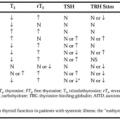CAUSES OF GYNECOMASTIA
Part of “CHAPTER 120 – GYNECOMASTIA“
PHYSIOLOGIC GYNECOMASTIA
Physiologic gynecomastia can be seen at the extremes of life. Neonatal gynecomastia usually is transient, reflecting the effect of the high level of estrogens in the maternal-fetal unit. The gynecomastia seen in senescence may be related to several factors. Older people may be more likely to develop (or to have developed) some of the various disorders associated with gynecomastia. Further, aging seems to be associated with a progressive primary testicular dysfunction, including low-normal or low serum testosterone levels, increases in serum LH and follicle-stimulating hormone (FSH), and normal or increased serum estrogen levels.10,11 The resulting increase in the circulating estrogen/androgen ratio then could account for gynecomastia. Some controversy revolves around whether this progressive loss of testicular function is related solely to aging per se or also reflects underlying diseases to which older people become susceptible12 (see Chap. 199). In addition, aging is associated with accumulation of adipose tissue, which is an important source of the aromatase enzyme that converts circulating androgen precursors to estrogens.
Physiologic gynecomastia is most common during sexual maturation; such pubertal gynecomastia can affect as many as two-thirds of normal adolescents. It usually lasts for only a few months to a few years but sometimes persists into adulthood. A wide variety of alterations in androgens, estrogens, or estrogen/androgen ratios have been described in subjects with pubertal gynecomastia,13,14,15 and 16 but their etiology and causative relation to the breast enlargement remain largely speculative. Persistent pubertal gynecomastia also has been called essential gynecomastia. In some cases, the breasts become female-appearing in size and conformation, and these otherwise hormonally normal adults have been said to have persistent pubertal macromastia.
TUMORS
Tumors of the steroid-producing organs (adrenal, testis) are an uncommon cause of gynecomastia but one that must be ruled out in a male with breast enlargement (see also Chap. 219). Feminizing adrenal tumors usually are malignant. Commonly, such tumors are large. Many are palpable, and they are easily seen by computed tomography or magnetic resonance imaging. Biochemically, they produce large amounts of various steroid precursors that can be detected as elevated plasma dehydroepiandrosterone sulfate (DHEAS) and serve as the substrate for peripheral conversion to estrogens. Serum estradiol levels are high.
In contrast to feminizing adrenal tumors, estrogen-producing tumors of the testis often are small and can be benign. If not palpable, they may be imaged by testicular ultrasound. Although estrogen-producing testicular tumors are usually of Leydig-cell origin, there is an association between gynecomastia, feminizing Sertoli cell tumors, and the Peutz-Jeghers syndrome.17
The gynecomastia associated with some tumors has been related to high levels of aromatase activity (which converts androgens to estrogens) within the tumor itself; this phenomenon has been noted in some testicular tumors18,19 as well as in hepatocellular carcinoma.20
Clinically, one should suspect an estrogen-producing neoplasm if gynecomastia is of rapid onset, if serum estrogen levels are very high, or if a mass is found in the abdomen or testis. Often, the autonomous estrogen production has suppressed the pituitary, leading to low serum LH and FSH levels and, consequently, to secondary hypogonadism and testicular atrophy.
More commonly, tumors lead to gynecomastia through the paraneoplastic production of gonadotropin, particularly hCG. This hormone and LH in high levels tend to stimulate testicular estrogen production disproportionate to androgen production, leading to increases in the circulating estrogen/androgen ratio. Testicular tumors are the most common neoplasm with clinically evident hCG production (7% of all testicular tumors are associated with gynecomastia21), but many other tumors can produce this hormone22 (see Chap. 122 and Chap. 219). Serum estrogen levels tend to be high, and serum hCG-β virtually always is elevated. Occasionally, the source of the ectopic hCG production is not evident, in which case catheterization of veins draining various organs to determine the source of the hormone can be helpful. In such cases, one should pay particular attention to the possibility of an occult testicular tumor.23
DRUGS
Medications commonly are implicated in gynecomastia24 (Table 120-2). For some drugs, studies have revealed the mechanism by which the estrogen/androgen ratio effect at the breast is increased. For exogenous estrogens, as in the treatment of prostate cancer, the mechanism of gynecomastia is self-evident. Other exposures to exogenous estrogen are not so apparent, however, such as estrogen-containing creams used by a spouse or mother or designed to treat baldness, foods prepared from estrogen-treated
animals, or occupational exposure during the manufacture of estrogen-containing medications.24a Crude marijuana extracts, but not the purified active ingredient tetrahydrocannabinol, interact with estrogen receptors, suggesting that marijuana-associated gynecomastia may reflect the presence of plant estrogens.25 Digitalis preparations also may have estrogen-like effects.
animals, or occupational exposure during the manufacture of estrogen-containing medications.24a Crude marijuana extracts, but not the purified active ingredient tetrahydrocannabinol, interact with estrogen receptors, suggesting that marijuana-associated gynecomastia may reflect the presence of plant estrogens.25 Digitalis preparations also may have estrogen-like effects.
Stay updated, free articles. Join our Telegram channel

Full access? Get Clinical Tree





